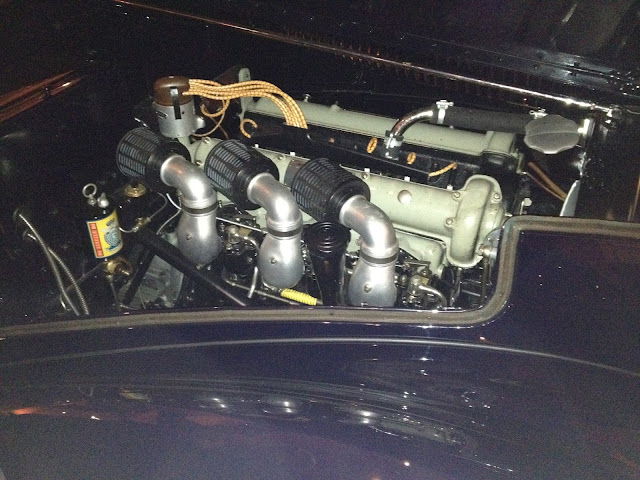Early dashboards were just that, flat panels inherited from horse-drawn carriages which kept the mud off passengers, and eventually collected a selection of engine controls, as well as a steering wheel, when horses left the scene. Gordon Buehrig's design for the dash of the 1936 Cord 810 made the lowly dash into an instrument panel, and the driver's seat into a command post. The engine-turned metal panel backing the gauges provided still more focus on the instruments, in a design scheme with little other decoration...
In 1949, Jaguar's XK120 roadsters featured fairly simple instrument panels, while the convertibles and closed coupes introduced a few years later treated driver and passenger to polished wood. The symmetrical design with central instrument binnacle was easy to adapt to either right or left-hand drive, important during Britain's postwar export drive...
Early Aston Martin DB2s featured a similar symmetry, probably for the same reason, and while the Jag XK120 driver got a bakelite steering wheel, Aston provided a wood rim. This is a DB2/4 from 1955...
But the Mark III version of Aston's DB2 featured a modern upgrade to an asymmetrical arrangement with instruments grouped around the wheel in a shape which repeated the shape of the famous Aston grille. No more wood on the dash, but more focus at the helm…and this is the first Aston Martin which appeared in the James Bond novels. The dash design worked so well it featured in the DB4, 5 and 6...
No survey of modern instrument panels would be complete without Flaminio Bertoni's design for the Citroen DS19. The asymmetrical design is dominated by the single-spoke safety steering wheel, and appropriate to the hydropneumatically-suspended, front-wheel drive space ship which hypnotized auto show crowds when it appeared in 1956.

Lancia's late 50s Flaminia series featured three different panel designs for the models offered by three coach builders: Pininfarina, Touring and Zagato. All featured similar instruments, but the sports models by Zagato and Touring got the wood-rimmed wheel. This is a Superleggera Touring-bodied 3C coupe; note the symmetrical ovals, one containing speedo and tachometer, and the other a glovebox. Not obvious is the lack of any kind of labels on that row of switches. During my brief but happy ownership of a similar car, I never managed to memorize the functions. Apparently Lancia decided that if you couldn't memorize the switchgear, you had no business sitting behind that pretty wood wheel...

Loewy Studios angled the '63 Studebaker Avanti's instruments at the ends of the binnacle towards the driver, and also carried the shape of the instrument hood forward through the windshield, providing a kind of indoor-outdoor integration featured in Midcentury Modern architecture, and also a convenient aid for aiming their new GT car. Studebaker chief Sherwood Egbert, a pilot, suggested moving some incidental switches to the windshield header, as on a plane.*
Chevrolet's Corvette Sting Ray, also from 1963, was hatched from a rough sketch by Pete Brock (see our post for 1/16/17) into an SCCA racer by Larry Shinoda, and by the time it reached production it featured this symmetrical, twin hooded instrument panel with the driver's station balanced by a generous lockable bin, perhaps a compensation for the Sting Ray's missing trunk lid...
This blue example, with extra instruments added for its owner, GM Styling VP Harley Earl, shows how easy it would've been to adapt the Sting Ray design to right-hand drive for export cars. But GM never made any right-hand drive 'Vettes, so Australian fans had local privateers convert a few cars for use Down Under...

Early in the same year the Sting Ray appeared, Jean Daninos, head of Facel Metallon and provider of special bodywork to French industry (first Ford and then Simca) released the ultimate version of his Chrysler-powered Facel Vega GT series, the Facel II. Also a symmetrical design with aircraft-inspired controls, it was available in right or left-hand drive. Ringo Starr picked a right-hander like this one. Daninos never tired of pointing out that nobody ever restyled one of his Facel Vegas. And this dash is interesting for another reason: while it is perhaps the most memorable wood-themed instrument panel in any car; none of it was sourced from a tree. Daninos preferred painted metal for safety reasons. The rim of that steering wheel, however, is wood...
*Footnote: For the Avanti design story, see our posts for 2/17/16 and 2/18/16.
Photo credits:
Top: smears.net
2nd: youtube.com
3rd: hemmings.com
4th: topclassiccarsforsale.com
5th: tradeuniquecars.com
6th: losson.com
7th: expertdrivers.blogspot.com
8th: Steve McKelvie
9th: mobile.web-cars.com
10th: hemmings.com
11th: pinterest.com




















































